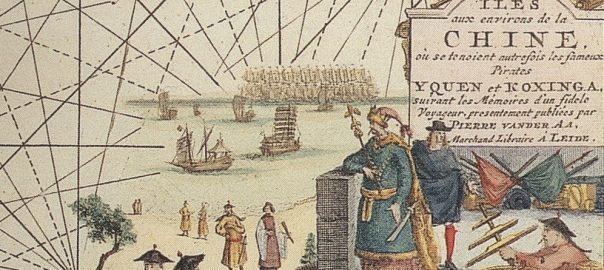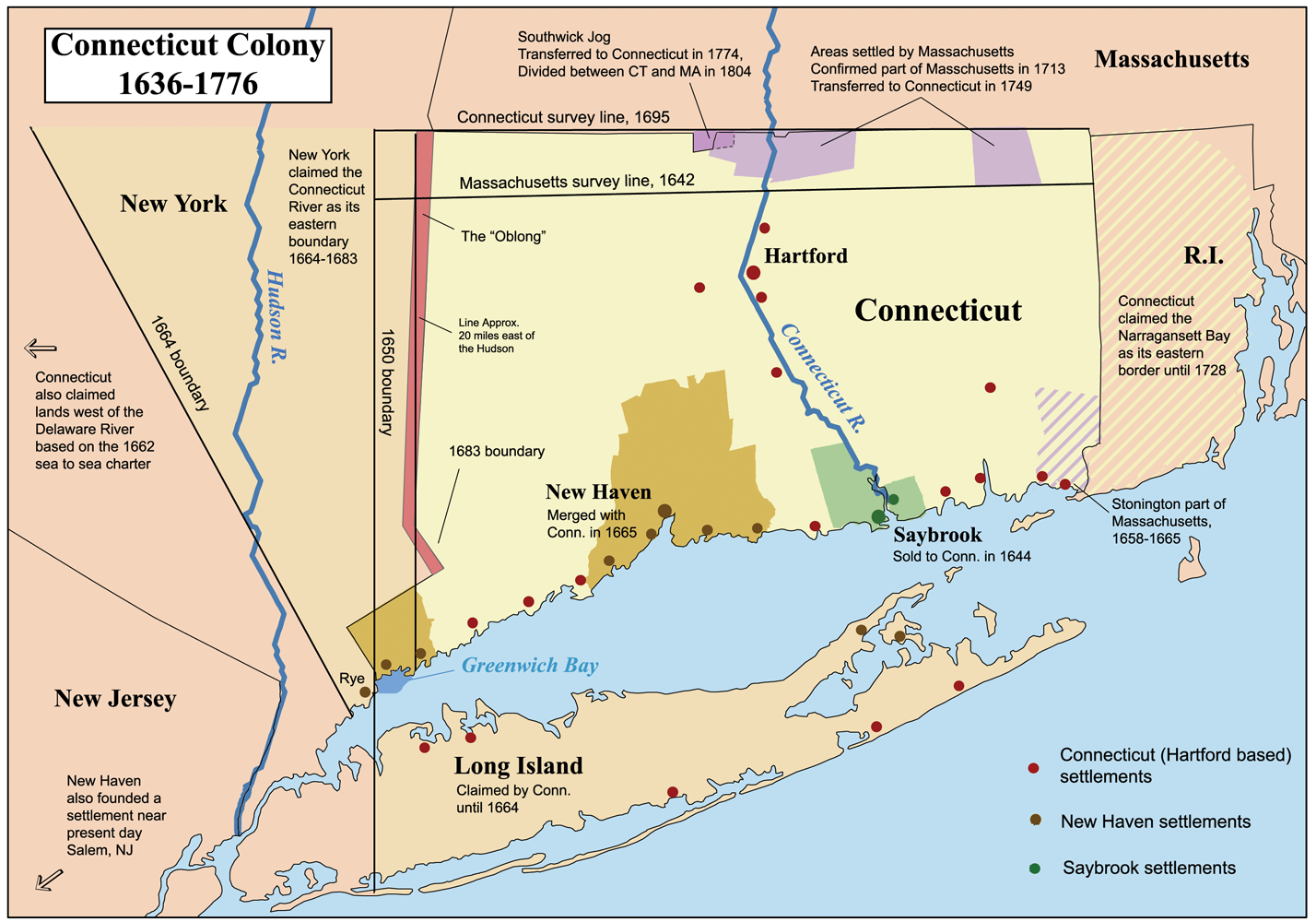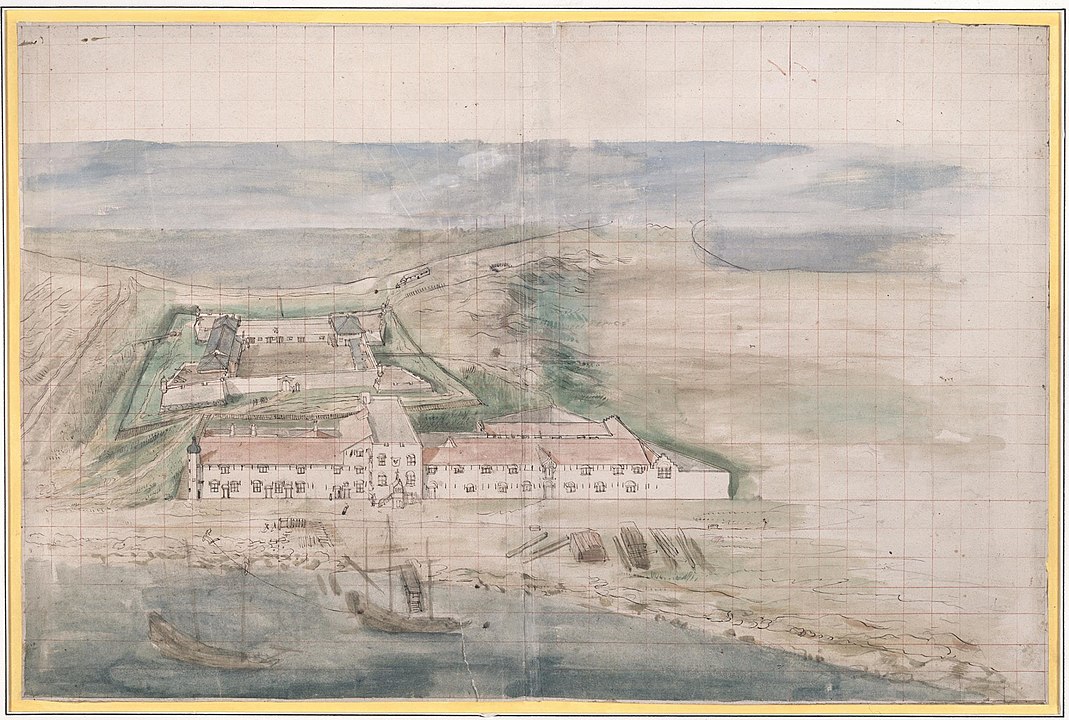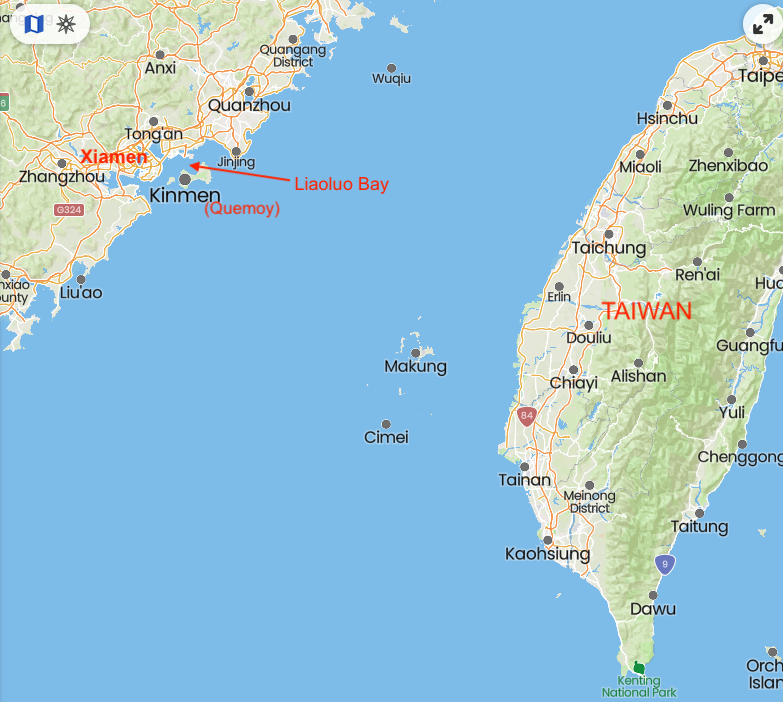In 1632 CE there were two notable developments in the story of the rise and maintenance of “the West”. Both featured contests among rival empires. In “Connecticut” (from the Mohegan word quonehtacut, meaning “place of long tidal river”), English colonists were challenging the Dutch empire’s claims to colonize it. In Liaoluo Bay, north of Kinmen/Quemoy Island off the coast of mainland China, the Ming navy clashed with the Dutch VOC navy.
I find this latter clash particularly interesting since (like the Mughal-Portuguese confrontation I reported on yesterday) it was between one of the era’s large land-based empires and one of the European-origined sea-based empires. It shared other intriguing features with the Mughal-Portuguese clash, too. So I’ll quickly start with Connecticut and then spend longer on the Battle of Liaoluo Bay .
English colonists challenge Dutch in Connecticut
In 1621, as we know, the government of the Dutch United Provinces awarded a “charter” to the Dutch GWC company to build the colony of “New Netherland” in North America– focusing on the three great rivers (running southwest to northeast) the Delaware, the Hudson, and the Connecticut. The English colonies in Virginia and the infant “Maryland” were pressing up against Dutch claims in the Delaware. And in 1633, the English colonists from the Massachusetts Bay Company started coming down to press against New Netherland in the Connecticut area.
The first European to enter and map the Connecticut River had been Dutchman Adriaen Block, who came in 1614. Later, the GWC had established a small fort on the river near today’s settlement of Hartford, which they called the “House of Hope”. (I imagine the numerous native peoples all around the river basin took little hope from its establishment.) But that was about all the GWC was able to do. Meantime, the English colonists in Massachusetts were– as is the nature of settler colonialism– eager to expand the area of their control and exploitation. English-WP tells us this:
The [English] Connecticut Colony was originally a number of separate, smaller settlements at Windsor, Wethersfield, Saybrook, Hartford, and New Haven. The first English settlers came in 1633 and settled at Windsor, and then at Wethersfield the following year. John Winthrop the Younger of Massachusetts received a commission to create Saybrook Colony at the mouth of the Connecticut River in 1635.
Controlling the mouth of any river-based chain of colonial settlements is obviously important for any sea-based empire!
WP continues:
The main body of settlers came in one large group in 1636. They were Puritans from Massachusetts Bay Colony led by Thomas Hooker, who established the Connecticut Colony at Hartford. The Quinnipiack Colony was established by John Davenport, Theophilus Eaton, and others at New Haven in March 1638. The New Haven Colony had its own constitution called “The Fundamental Agreement of the New Haven Colony”, signed on June 4, 1639.
The settlements were established without official sanction of the English Crown, and each was an independent political entity. In 1662, Winthrop traveled to England and obtained a charter from Charles II which united the settlements of Connecticut.
Honestly, once the first English settlers had come, there was no further mention of the Dutch in that area. There was, however, significant resistance from the indigenous peoples, especially the Pequots.
And now let’s see what was happening with the Dutch in Asia.
Ming and Dutch navies clash (twice) in Taiwan Strait
In 1624, the Ming navy had forced the Dutch VOC fleet off the Pescadores Islands that lie in the middle of the Strait of Taiwan and the Dutch then established a naval base at the southwest end of Taiwan that they called “Fort Zeelandia.” What the VOC leaders there most wanted was to get permission from the Ming Dynasty government of China’s vast, productive, technologically accomplished and definitely land-based empire to conduct trade with some of the great ports along the empire’s lengthy coast. (The Portuguese, who were the VOC’s main European competitors, had had one trading mission within China, at Macau, for some decades.)
1624 had been a setback for the VOC. So from Zeelandia, they stepped up the activities they had long engaged in alongside many rogue Chinese pirate allies, of harassing shipping along the coast or trying to squeeze good protection money from the trading and shipping vessels traveling along it. Until 1628, one of the most powerful Chinese pirate leaders had been Zheng Zhilong. But that year, he traded in his pirate’s cap for an admiral’s helmet and managed to sell his services to the leaders of the (already rapidly weakening) Ming Dynasty.
English-WP tells us this about what happened in early 1633:
Zheng Zhilong had adapted European technology throughout his maritime career, decking his ships with European cannons and mercenaries, and in 1633 he had built a new fleet according to European designs: whereas most Chinese junks held at most eight smaller cannons, Zheng’s new ships had two reinforced gundecks that could hold up to thirty-six large guns, shooting out of Western-inspired gunports. According to a Dutch account, these “large, beautiful war junks were equipped with large cannons, some of them having more than our own warships.”
Even Hans Putmans, the admiral of the VOC forces in Fort Zeelandia was impressed. He would later write about these ships: “Never before in this land so far as anyone can remember, has anyone seen a fleet like this, with such beautiful, huge, well-armed junks.”
The new ships were being built in Amoy (Xiamen) on the coast of Fujian. Before they were finished Putmans led a small fleet into Amoy harbor, apparently on a “friendly” visit. Then, this:
The Dutch fired at the Chinese fleet without warning. The ships had not been crewed yet and were filled with workers, who jumped ship. As soon as it was apparent that the Chinese would offer no retaliation, Putmans ordered his men to burn the ships to save powder. Three large junks escaped being burned or hacked to pieces and the Dutch suffered only one casualty — a sailor who had died setting a fire.
Following the destruction of Zheng Zhilong’s fleet, the Dutch roamed the seas with impunity, pillaging villages and capturing vessels. The pirates Liu Xiang and Li Guozhu joined Putmans, and for a time it seemed the Dutch were becoming the head of a new pirate coalition that operated off the coast of China, with at least 41 pirate junks and 450 Chinese soldiers. Putmans hoped these piratical activities would force China to agree to his demands for free trade; but they had the opposite effect, Putmans’s actions had united the political enemies Zheng Zhilong and Zou Weilian together.
The VOC’s fleet of eight vessels, along with the 50 junks sailed by Putmans’ Chinese allies, spent much of the remaining summer and early fall of 1633 headquartered in Liaoluo Bay, just north of Kinmen/Quemoy Island. That was tauntingly close to Xiamen, where Zheng was quietly planning his revenge. He gathered a fleet of, “around 150 junks consisting of imperial ships, merchant ships, and his own personal vessels. Fifty of these were large junks.”
On October 22, Zheng attacked:
Zheng’s fleet met the Dutch ships and fifty ships from Chinese pirate allies. Zheng ordered his fleet to ignore the latter and focus on attacking the Dutch fleet. Knowing that the Chinese ships could not match the Dutch ships in a firefight, Zheng Zhilong instead resolved to use fireships. In order to fool the Dutch to expect otherwise, Zheng chose to use large warjunks as the fireships, decking them with cannon and soldiers (who were equipped with bamboo tubes [for flotation?] and were to jump overboard just before crashing the ship into the enemy fleet). The Dutch did not expect the large warjunks to come straight at them, hence they did not even have time to raise their anchors. Ming fireships set fire to the Broeckerhaven. Slooterdijck was hooked on by four Chinese warships… Hans Putmans fled with the Perdam, Zeeburg, Wieringen and Bleiswijk to [Taiwan]…
Ming officials hailed the victory as a “miracle at sea”, as [Zheng’s longtime rival] Zou Weilian observed that people had felt “ever since the red barbarians [the Dutch] arrived… this kind of victory had been extremely rare”. The victory at Liaoluo Bay had reestablished the prestige and authority of China in the Taiwan Strait, as Hans Putmans ceased his piratical activities on the Chinese coast. Putmans’s superiors in Batavia especially ordered him to stay away from China and “out of harm’s way so [Dutch ships] won’t be exposed to the kind of fury and resolution the Chinese displayed at Liaoluo Bay.” However, Putmans felt that his plan had not came to naught, since the Dutch “showed what damage and disruption we can cause them, and it appears that even though they held the field, destroyed two of our yachts, and drove us from their coast, they still came seeking peace with us, and have granted us better trade than ever.”
Zheng Zhilong also prospered. He had earned Zou Weilian’s respect through this battle. Zou recommended Zheng for promotion in a memorial to the throne but Zheng, in his newfound fame as someone who could keep the Dutch under control, used his influence to remove Zou from power. Now that Zheng had removed political opposition, he was free to grant the Dutch trading privileges, which was what both Zheng and Putmans wanted originally.
Whoa! This was almost exactly the same outcome the Portuguese had won from the Mughals at Hooghly just last year! What can we learn from these two trains of events about the relationship between the relatively young sea-based empires that four West European powers were now wielding in the world’s oceans and the strong (non-European), land-based empires that still existed, primarily in Asia?
(By the way, the banner image at the head of this page is an engraving showing Zheng Zhilong and his brother, who became a renowned anti-Ming pirate leader.)
Land-based empires dealing with sea-based empires
I have long been of the view that, in the context of the Mediterranean, the Baltic, the Persian Gulf, or other bodies of water of relatively limited size, such seas would historically unite cultures and peoples, while massive mountains, deserts, or other land features would act as hard-to-traverse natural boundaries between them. Navigable rivers or inland seas or lakes would similarly link peoples and cultures. Sometimes, the bodies of water across which rich social, cultural, and economic interaction would occur could be quite large. Polynesian boats effected seaborne voyages of great length in the South Pacific. Arab dhows from Oman and elsewhere in the Arabian Peninsula took Islam and trade goods along all the shores of the Indian Ocean and into all the archipelagoes of the East Indies.
Meantime, throughout history, there have been numerous very large and powerful land-based empires– using the term “empire” to denote a single political system that held sway over a large chunk of land holding a significant human population that contained numerous different linguistic or cultural sub-groups. The Mongol Empire came sweeping out of Central Asia until it controlled nearly all the Eurasian landmass. (and it left many traces in both Europe and Asia, including in the form of the Mughals–their name itself being a bastardization of the term “Mongol”) and in the Jurchens/Late Jin who are about to topple the Ming in China. (Oops, spoiler alert there. Sorry.) The Americas saw three great land empires that in the early 1500s were all in turn toppled by the Spanish conquistadores. There were great river-based empires like Ancient Egypt, the earlier empires of the Fertile Crescent or the Indus Valley. The Greeks of classical times had started out maritime but acquired land-fighting skills that took them as far as Afghanistan. In the early-modern era I’ve been writing about, there were three great land-based Muslim empires: the Mughals, the Safavids, and the Ottomans.
Land-based empires were usually created and maintained only through what we today would consider to be massive violations of human rights. Resisters or rebels were ruthlessly suppressed. But in many cases, if a group of people wanted to maintain a serious resistance, they would have an option to retreat deeper into the interior, or to ally themselves with opposing forces on the boundaries of the empire. Pacifying the borders was always a challenge for any empire; and it was generally achieved through diplomacy and doing local deals as much as through ruthless suppression.
In the early 15th century, the Portuguese were the first Europeans to introduce two new factors into this equation of inter-polity relations. They were: long-distance navigation, and advances in heavy weaponry. For shorthand we could call it the Naval/Gunnery revolution.
Off the North Sea coasts of Iberia and the rest of Europe, the Portuguese had developed their naval/gunnery capabilities by fighting against the Muslims during the Reconquista. (They apparently took a lot of their early ship-design ideas directly from their Muslim opponents.) Big guns were already, I think, mainly being produced in Northern Europe, but the Portuguese mariners were easily able to sail up there to acquire the goods. Then they took their well-armed caravels slowly down Africa, around the Cape of Good Hope, and into the already well-traveled sea-lanes that knot the Indian Ocean into a single trading zones. Here’s the thing: they arrived in the Indian Ocean by sea; but for them, their traders, and the missionaries who were an integral part of their venture, what happened on land was always an integral part of their project. They needed their access to port cities and they hoped that over time the terrestrial powers who controlled the ports would understand that they needed the Portuguese empire-builders, too.
Which was what we saw happen at Hoogly in 1632: The Mughal empire under Emperor Shah Jahan first of all expelled the Portuguese, then when they had been suitably chastized (and he had suitably demonstrated his powers to his detractors or doubters back home), he invited them back. And that was what happened at Liaoluo Bay in 1633. Zheng felt he needed to fight the Dutch and demonstrate a “victory” before– and this seems to have happened fairly swiftly– he invited Adm. Putmans back into his parlor for a quick shot of mao tai as they settled on the details of the trading relationship going forward.
What the Spanish had been doing in the Americas since 1492 was notably different. Yes, they encountered three large, capable, and apparently sophisticated empires there. But they never felt they needed to “do any deals” with those empires, and tragically that judgement was proved correct. The military superiority the Spanish had over the Aztec, Mayan and Inca empires was not wholly maritime. They, unlike the Portuguese or later the Dutch, had significant and well-skilled land-fighting formations that they brought to the Americas: brothers and close cousins of the much-feared Habsburg Tercios who had first honed their skills in the Reconquista of Granada and then continued refining it through the many land-wars the Habsburgs continued fighting in Europe well into the 17th century. So no Spanish Conquistador in the Americas ever felt he needed to make any kind of a deal with an indigenous leader there that was any more serious, long-lasting, or binding than a short-term, tactical agreement. For the Portuguese in Hooghly, or Adm. Putmans in Taiwan, the situation was very different. The land-based empires with whom they were dealing still had considerable power. How much longer would that continue to be the case?





